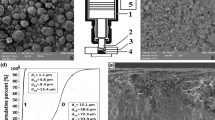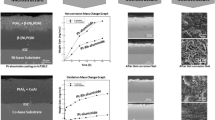Abstract
The role of using pulsed laser deposition (PLD) as a means for applying alumina (Al2O3) and chromia (Cr2O3) coatings to the HAYNES® 214® alloy was investigated to provide oxidation resistance in air at 800 °C. Using various material characterization techniques, it was found that an amorphous Cr2O3 coating approximately 150 nm thick could promote and maintain the formation of a protective α-Al2O3 scale for durations of at least 100 h of exposure. The Cr2O3-coated alloy also provided superior protection under thermal cycling conditions. The Al2O3-coated alloy provided results comparable to the uncoated alloy in all isothermal oxidation tests performed; however, it appeared to provide some benefit under thermal cycling conditions.








Similar content being viewed by others
References
HAYNES® 214® alloy. Principal Features. (n.d.). http://www.haynesintl.com/alloys/alloy-portfolio_/High-temperature-Alloys/haynes-214-alloy/principal-features.
A. Chyrkin, N. Mortazavi, M. Halvarsson, D. Grüner, and W. J. Quadakkers, Effect of thermal cycling on protective properties of alumina scale grown on thin Haynes 214 foil. Corrosion Science 98, 2015 (688). https://doi.org/10.1016/j.corsci.2015.06.020.
D. J. Young, A. Chyrkin, J. He, D. Grüner, and W. J. Quadakkers, Slow Transition from Protective to Breakaway Oxidation of Haynes 214 Foil at High Temperature. Oxidation of Metals 79, 2013 (405). https://doi.org/10.1007/s11085-013-9364-4.
A. K. Singh, S. Kaity, K. Singh, J. Thomas, T. R. G. Kutty, and S. Sinha, Pulsed laser deposition of alumina coating for corrosion protection against Liquid Uranium. Materials Chemistry and Physics. 143, 2014 (1446). https://doi.org/10.1016/j.matchemphys.2013.11.063.
F. GarcíaFerré, M. Ormellese, F. Di Fonzo, and M. G. Beghi, Advanced Al2O3 coatings for high temperature operation of steels in heavy liquid metals: A preliminary study. Corrosion Science. 77, 2013 (375–378). https://doi.org/10.1016/j.corsci.2013.07.039.
A. Hajjaji, A. Rebhi, I. Ka, K. Trabelsi, M. Gaidi, B. Bessais, and M. A. El Khakani, Pulsed-laser-deposited lead sulfide nanoparticles based decoration of porous silicon layer as an effective passivation treatment for multicrystalline silicon. Applied Surface Science 505, 2020 (144590). https://doi.org/10.1016/j.apsusc.2019.144590.
L. Doeswijk, H. H. C. de Moor, D. H. A. Blank, and H. Rogalla, Passivating TiO2 coatings for silicon solar cells by pulsed laser deposition. Appl. Phys. A 69, 1999 (S409). https://doi.org/10.1007/s003390051427.
S. House, H. Ayoola, J. Lyons, B. Li, J. Yang, and B. Gleeson, Promoting protective scale formation at lower temperatures via surface finishing: Effects on the establishment, structure, and chemistry in Haynes 214 high-temperature oxidation-resistant nickel alloy. Microscopy and Microanalysis. 27, 2021 (2868). https://doi.org/10.1017/s143192762101000x.
P. Saltykov, O. Fabrichnaya, J. Golczewski, and F. Aldinger, Thermodynamic modeling of oxidation of Al–Cr–Ni alloys. Journal of Alloys and Compounds 38, 2004 (99). https://doi.org/10.1016/j.jallcom.2004.02.053.
A. Shaaban, Influence of NiAl2O4 spinel formation on the oxidation behavior of the Ni50Al alloy at 1273 K in air. Surface and Coatings Technology 379, 2019 (125023). https://doi.org/10.1016/j.surfcoat.2019.125023.
Z. Wang, S. K. Saxena, P. Lazor, and H. S. C. O’Neill, An in situ Raman spectroscopic study of pressure induced dissociation of spinel NiCr2O4. Journal of Physics and Chemistry of Solids. 64, 2003 (425). https://doi.org/10.1016/S0022-3697(02)00328-1.
R. Krishnan, R. Kesavamoorthy, S. Dash, and A. K. Tyagi, Baldev Raj, Raman Spectroscopic and photoluminescence investigations on laser surface modified α-Al2O3 coatings. Scripta Materialia 48, 2003 (1099). https://doi.org/10.1016/S1359-6462(02)00631-0.
J. S. Zabinski, N. T. McDevitt, Raman spectra of inorganic compounds related to solid state tribochemical studies. Wright laboratories Wright-Patterson AFB OH (1998).
R. L. Farrow and A. S. Nagelberg, Raman spectroscopy of surface oxides at elevated temperatures. Applied Physics Letters 36, 1980 (945). https://doi.org/10.1063/1.91659.
Hosterman, Brian D., "Raman Spectroscopic Study of Solid Solution Spinel Oxides" (2011). UNLV Theses, Dissertations, Professional Papers, and Capstones. 1087. https://doi.org/10.34917/2476131.
M. A. Laguna-Bercero, M. L. Sanjuán, and R. I. Merino, J. Phys.: Condens. Matter 19, 2007 (186217). https://doi.org/10.1088/0953-8984/19/18/186217.
A. Muan and S. Somiya, Phase equilibrium studies in the system iron oxide-Al2O3-Cr2O3. J. Am. Ceram. Soc. 42, 1959 (603). https://doi.org/10.1111/j.1151-2916.1959.tb13581.x.
H. Asteman and M. Spiegel, A comparison of the oxidation behaviours of Al2O3 formers and Cr2O3 formers at 700 °C – oxide solid solutions acting as a template for nucleation. Corrosion Science. 50, 2008 (1734). https://doi.org/10.1016/j.corsci.2007.12.012.
P. Zhao, H. Zhao, J. Yu, H. Zhang, H. Gao, and Q. Chen, Crystal structure and properties of Al2O3-Cr2O3 solid solutions with different Cr2O3 contents. Ceramics International. 44, 2018 (1356). https://doi.org/10.1016/j.ceramint.2017.08.195.
C. Wagner, Reaktionstypen bei der Oxydation von Legierungen. Z. Elektrochem. 63, 1959 (772). https://doi.org/10.1002/bbpc.19590630713.
B. Gleeson, Thermodynamics and theory of external and internal oxidation of alloys. Shreir’s Corrosion 2010. https://doi.org/10.1016/b978-044452787-5.00012-3.
A. Chyrkin, W. G. Sloof, R. Pillai, T. Galiullin, D. Grüner, L. Singheiser, and W. J. Quadakkers, Modelling compositional changes in nickel base alloy 602 CA during high temperature oxidation. Materials at High Temperatures 32, 2015 (102). https://doi.org/10.1179/0960340914Z.00000000082.
R. A. Rapp, The transition from internal to external oxidation and the formation of interruption bands in silver-indium alloys. Acta Metallurgica. 9, 1961 (730). https://doi.org/10.1016/0001-6160(61)90103-1.
W. Zhao, Y. Kang, J. M. A. Orozco, and B. Gleeson, Quantitative Approach for Determining the Critical Volume Fraction for the Transition from Internal to External Oxidation. Oxid Met 83, 2015 (187). https://doi.org/10.1007/s11085-014-9516-1.
F. Gesmundo and F. Viani, Transition from internal to external oxidation for binary alloys in the presence of an outer scale. Oxid Met 25, 1986 (269). https://doi.org/10.1007/BF01072908.
P. Zhang, K. Yuan, R. L. Peng, X.-H. Li, and S. Johansson, Long-term oxidation of MCrAlY coatings at 1000°C and an Al-activity based coating life criterion. Surface and Coatings Technology 332, 2017 (12). https://doi.org/10.1016/j.surfcoat.2017.09.086.
Y.-F. Su, L. F. Allard, D. W. Coffey, and W. Y. Lee, Effects of an α-Al2O3 Thin Fim on the Oxidation Behavior of a Single-Crystal Ni-Based Superalloy. Metall. Mater. Trans. A 35A, 2004 (1055). https://doi.org/10.1007/s11661-004-0031-x.
M. P. Brady, B. Gleeson, and I. G. Wright, Alloy Design Strategies for Promoting Protective Oxide-Scale Formation. JOM 52, 2000 (16). https://doi.org/10.1007/s11837-000-0109-x.
K. Okada, A. Hattori, T. Taniguchi, A. Nukui, and R. N. Das, Effect of divalent cation additives on the γ-Al2O3-to-α- Al2O3 phase transition. Journal of the American Ceramic Society. 83, 2004 (928). https://doi.org/10.1111/j.1151-2916.2000.tb01296.x.
S. Lamouri, M. Hamidouche, N. Bouaouadja, H. Belhouchet, V. Garnier, G. Fantozzi, et al., Control of the γ-alumina to α-alumina phase transformation for an optimized alumina densification. Boletín De La Sociedad Española De Cerámica y Vidrio. 56, 2017 (47). https://doi.org/10.1016/j.bsecv.2016.10.001.
Y. Yoshizawa, K. Hirao, and S. Kanzaki, Fabrication of low cost fine-grained alumina powders by seeding for high performance sintered bodies. Journal of the European Ceramic Society. 24, 2004 (325). https://doi.org/10.1016/s0955-2219(03)00226-7.
W. M. Zeng, L. Gao, and J. K. Guo, A new sol–gel route using inorganic salt for synthesizing Al2O3 nanopowders. Nanostructured Materials. 10, 1998 (543). https://doi.org/10.1016/s0965-9773(98)00095-6.
Acknowledgements
The authors acknowledge Dr. Bingtao Li for helpful discussions and Dr. Rocco Cerchiara for TEM characterization. This work was financially supported by the Technology Innovation Program (ATC+ Project #20014176) funded by the Ministry of Trade, Industry & Energy (MOTIE, Korea).
Author information
Authors and Affiliations
Contributions
ES mainly performed the experiment and wrote the first draft. HM conducted corrosion testing, and SL contributed to PLD film deposition. MT, DL, and HT performed Raman spectroscopy and data analysis. BG contributed to the data interpretation and reviewed the manuscript. JL managed overall research and revised the manuscript.
Corresponding author
Ethics declarations
Competing interests
The authors declare no competing interests.
Additional information
Publisher's Note
Springer Nature remains neutral with regard to jurisdictional claims in published maps and institutional affiliations.
Rights and permissions
Springer Nature or its licensor (e.g. a society or other partner) holds exclusive rights to this article under a publishing agreement with the author(s) or other rightsholder(s); author self-archiving of the accepted manuscript version of this article is solely governed by the terms of such publishing agreement and applicable law.
About this article
Cite this article
Stowe, E.R., Ma, H., Lee, S. et al. Passivation of the HAYNES® 214® Nickel-Based Superalloy via Pulsed Laser Deposition of Alumina and Chromia Coatings for Enhanced Corrosion Resistance at Intermediate Temperatures. High Temperature Corrosion of mater. 100, 525–539 (2023). https://doi.org/10.1007/s11085-023-10199-7
Received:
Revised:
Accepted:
Published:
Issue Date:
DOI: https://doi.org/10.1007/s11085-023-10199-7




